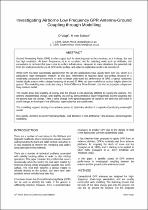 ResearchSpace
ResearchSpace
Investigating airborne low frequency GPR antenna-ground coupling through modelling
JavaScript is disabled for your browser. Some features of this site may not work without it.
- ResearchSpace
- →
- Research Publications/Outputs
- →
- Conference Publications
- →
- View Item
| dc.contributor.author |
Vogt, D

|
|
| dc.contributor.author |
Van Schoor, Michael

|
|
| dc.date.accessioned | 2014-02-13T08:43:18Z | |
| dc.date.available | 2014-02-13T08:43:18Z | |
| dc.date.issued | 2013-10 | |
| dc.identifier.citation | Vogt, D. and Van Schoor, M. 2013. Investigating airborne low frequency GPR antenna-ground coupling through modelling. In: South African Geophysical Association 13th Biennial Conference and Exhibition, Kruger Park, 6-9 October 2013 | en_US |
| dc.identifier.uri | http://earthdoc.eage.org/publication/publicationdetails/?publication=73057 | |
| dc.identifier.uri | http://hdl.handle.net/10204/7187 | |
| dc.description | South African Geophysical Association 13th Biennial Conference and Exhibition, Kruger Park, 6-9 October 2013. Abstract only attached. | en_US |
| dc.description.abstract | Ground Penetrating Radar (GPR) is often a good tool for detecting near surface structure, as it is cheap, fast and has high resolution. At lower frequencies, it is an excellent tool for detecting voids such as sinkholes, old excavations or rat-holes that pose a risk to surface infrastructure. However, in some situations, the potential risk from the voids prevents the use of GPR on the surface, and airborne application needs to be considered. While GPR has been successfully applied from the air, the applications have usually been over ice, which is a particularly radar transparent medium. In this case, information is required about sub-surface structure in a moderately conductive environment. In order to better understand the performance of GPR, a typical resistively loaded dipole antenna with a design frequency of around 50 MHz has been modelled at various heights above the ground. The modelling was conducted using a Finite-Difference Time-Domain code that incorporates a dispersive lossy medium model. The results show that coupling of energy into the ground is not adversely affected by raising the antenna. The antenna characteristics change, with slightly less energy being emitted at lower frequencies, but the coupling into the ground does not change. There is some change in the spreading pattern of signals in the earth that will result in small changes in the shape of the diffraction hyperbolas that are usually seen. The modelling supports testing of an airborne system to determine whether it is capable of producing meaningful results. | en_US |
| dc.language.iso | en | en_US |
| dc.publisher | SAGA (South African Geophysical Association) | en_US |
| dc.relation.ispartofseries | Workflow;11065 | |
| dc.subject | Ground Penetrating Radar | en_US |
| dc.subject | GPR | en_US |
| dc.subject | Surface structure detection | en_US |
| dc.subject | Airborne Ground Penetrating Radar | en_US |
| dc.subject | Void detection | en_US |
| dc.subject | Finite-Difference Time-Domain | en_US |
| dc.subject | Electromagnetic modelling | en_US |
| dc.title | Investigating airborne low frequency GPR antenna-ground coupling through modelling | en_US |
| dc.type | Conference Presentation | en_US |
| dc.identifier.apacitation | Vogt, D., & Van Schoor, A. M. (2013). Investigating airborne low frequency GPR antenna-ground coupling through modelling. SAGA (South African Geophysical Association). http://hdl.handle.net/10204/7187 | en_ZA |
| dc.identifier.chicagocitation | Vogt, D, and Abraham M Van Schoor. "Investigating airborne low frequency GPR antenna-ground coupling through modelling." (2013): http://hdl.handle.net/10204/7187 | en_ZA |
| dc.identifier.vancouvercitation | Vogt D, Van Schoor AM, Investigating airborne low frequency GPR antenna-ground coupling through modelling; SAGA (South African Geophysical Association); 2013. http://hdl.handle.net/10204/7187 . | en_ZA |
| dc.identifier.ris | TY - Conference Presentation AU - Vogt, D AU - Van Schoor, Abraham M AB - Ground Penetrating Radar (GPR) is often a good tool for detecting near surface structure, as it is cheap, fast and has high resolution. At lower frequencies, it is an excellent tool for detecting voids such as sinkholes, old excavations or rat-holes that pose a risk to surface infrastructure. However, in some situations, the potential risk from the voids prevents the use of GPR on the surface, and airborne application needs to be considered. While GPR has been successfully applied from the air, the applications have usually been over ice, which is a particularly radar transparent medium. In this case, information is required about sub-surface structure in a moderately conductive environment. In order to better understand the performance of GPR, a typical resistively loaded dipole antenna with a design frequency of around 50 MHz has been modelled at various heights above the ground. The modelling was conducted using a Finite-Difference Time-Domain code that incorporates a dispersive lossy medium model. The results show that coupling of energy into the ground is not adversely affected by raising the antenna. The antenna characteristics change, with slightly less energy being emitted at lower frequencies, but the coupling into the ground does not change. There is some change in the spreading pattern of signals in the earth that will result in small changes in the shape of the diffraction hyperbolas that are usually seen. The modelling supports testing of an airborne system to determine whether it is capable of producing meaningful results. DA - 2013-10 DB - ResearchSpace DP - CSIR KW - Ground Penetrating Radar KW - GPR KW - Surface structure detection KW - Airborne Ground Penetrating Radar KW - Void detection KW - Finite-Difference Time-Domain KW - Electromagnetic modelling LK - https://researchspace.csir.co.za PY - 2013 T1 - Investigating airborne low frequency GPR antenna-ground coupling through modelling TI - Investigating airborne low frequency GPR antenna-ground coupling through modelling UR - http://hdl.handle.net/10204/7187 ER - | en_ZA |





